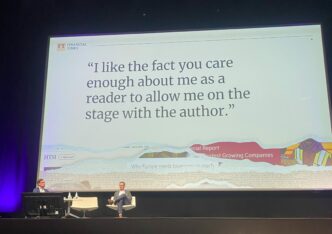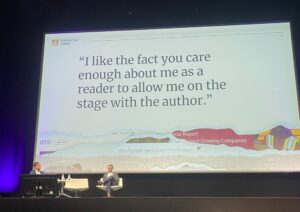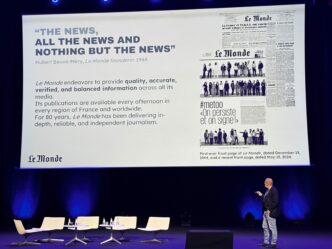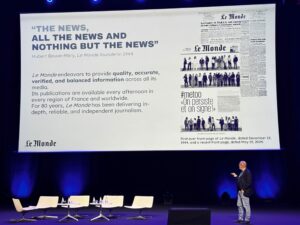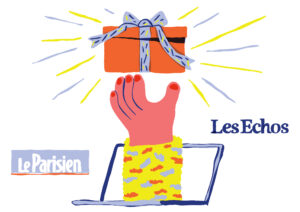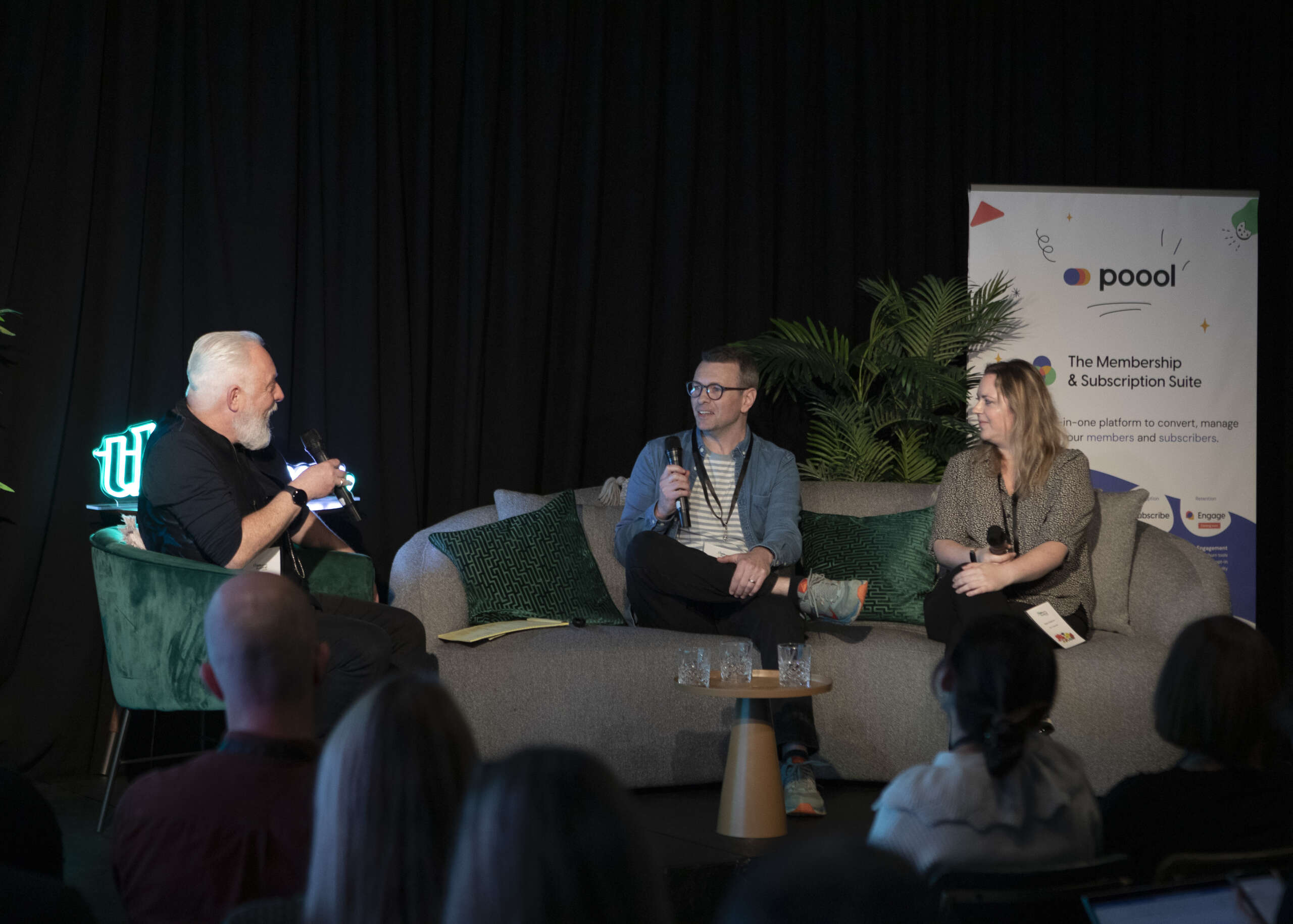

The Audiencers' Festival in London in October did not disappoint, with 145 digital publishing professionals the afternoon was filled with insightful conversations both on and off stage. To reflect this, we're publishing not just one, but a series of takeaway articles from the event! Our second panel session of the day: How to make newsletters valuable in a reader revenue model On the panel: - Peter Houston, a third of Media Voices & Host of The Newsletter Awards - Maire Bonheim, Head of Newsletters at The Telegraph - Michael MacLeod, Founder of The Edinburgh Guardian
The Telegraph needs no introduction. The subscription-focused British publisher currently has 34 newsletters, 6 of which are reserved for subscribers only, each with their own goal and metrics to track success.
Whilst Michael, who kindly jumped on a train from Scotland to join us, quit his job at Meta to launch The Edinburgh Guardian, a Substack, hyper-local newsletter, curating content on the life, news, culture and communities in the city.
“The whole concept grew out of the horrible user experience of having to file through the adverts on publisher’s sites to find the news that’s worth reading. I do this work so readers don’t have to, putting it in a short, curated digest.“
What is it that’s so special about newsletters?
Maire revealed that, at The Telegraph, they know that if a reader subscribes to their premium product after clicking on a newsletter, they’re 50% more likely to still be a subscriber after 12 months.
At The Edinburgh Guardian, retention rate is incredibly high. Only 5 people have ever unsubscribed, and one of these had simply moved cities. This is in part thanks to the regularity of the email, sent every morning to fit into a reader’s daily routine. Upon surveying his reader base, more than half shared that they start their day by reading the newsletter in bed.
This speaks to how genuinely useful newsletters are for building habits and relationships, being in direct contact with a person on a daily or weekly basis. And this is the key point here. Even for The Telegraph, as one of the UK’s largest newspapers, newsletters come from a single editor who establishes a very human, close relationship with their readers, speaking to them in the very personal inbox as if they know them, also leaving the floor open to replies.
For Michael, the inbox is one of the few remaining “safe spaces” to converse with readers. So whilst it’s incredibly valuable, we should be careful with this trust. It’s a relationship, and there’s expectations and trust in both directions.
How can you build this relationship?
In a time of AI and machine-written content, being ‘human’ is a differentiator. And replying to emails – establishing a 2 way conversation – is a useful way to do this in the newsletter space.
The Telegraph’s subscriber-only newsletter, “Your Royal Appointment”, for instance, answers a reader question each week. These readers are incredibly engaged thanks to the niche topic and will write in with the hope of being featured. The team even goes so far as to follow some of the replies further. For example, during the coronation, one reader wrote in to ask where they should stand to watch the procession. After replying in the newsletter, the team went to meet this reader, interview them and share it back into the newsletter.
As for Michael on Substack, the tool makes it easy to reply to emails and 50% of content now comes from readers. However, as a one-man-team with a growing user base, it’s not always easy to reply.
“In my opinion, you should keep doing things you can’t scale until you can’t!” So he’s still saying thank you to readers for their replies, sending them the links if their content is published, etc.
But the value of replying is worth the time, hence why The Telegraph still aims to build this relationship with readers, despite the huge scale.
“It’s a demanding role, running newsletters. You’re not just commissioning or producing but also community building with readers, writing and editing, proofing, design and relationship building with other teams. It’s very cross departmental, a true bridge role.”
Michael added: “Sometimes you have to accept that you can’t reply to everything. But there are smaller ways to engage with people at scale. At Vogue, we would use an emoji to react to comments and pin the top replies on Instagram posts. Even this small interaction makes a difference.”
How can cross-departmental work in the newsletter space?
Bridge roles were a big talking point at The Festival, and there’s no doubt that newsletters require multiple teams to work together.
The key takeaway from this part of the discussion was to be part of meetings:
- Make sure you’re in the room, building connections with and between people
- If there’s an area you know less of, get yourself invited to their regular catch-ups
- Look for ways to communicate with people in the way they work
- Be responsible for something that you think everyone’s going to use as a way to bed yourself in their work
The context of the newsletter “bridge role” at The Telegraph:
There are currently 34 newsletters at The Telegraph. But this is in constant fluctuation as they review what’s working and what isn’t, testing and iterating between the editorial, product and engagement teams.
Last year, they did a huge portfolio review, merging some newsletters that were doing similar things.
“As much as you want to fill every niche, you also don’t want to spread yourself thin and double up on the same content where it’s not necessary. For instance we merged a few fashion and beauty newsletters into a single, daily lifestyle newsletter.”
Equally, there’s new launches whenever they see a gap – such as their “Conversations” newsletter…
They noticed that the number of comments under articles were consistently increasing and, very frequently, the top-read articles were on the “Letters to the editor” page. So, they workshopped with the teams who worked on these pages, as well as the research team, to develop a new newsletter based around this interest. This newsletter has gone on to win an award at the Media Voices’ Newsletter Awards earlier this year
In general, decision-making in the newsletter space at The Telegraph is based on editorial judgement and curation, leading with data but introducing some wild cards and experimentation.
“Doing more with less” at The Edinburg Guardian:
Michael noticed that readers clicked most on articles about shop openings, so considered launching a newsletter focused only on that. But when he surveyed people 60% of readers said don’t change it, don’t do anything else.
The takeaway: don’t follow the data too much. You’ll build an increasingly small bubble around you and keep you from innovating and experimenting.
“If you only follow the data, you’re only going to get what you’ve already got.”
What does the user funnel look like to convert readers into revenue?
As a one-man-team, Michael is very close to the funnel, and Substack has helped him to get started with subscriptions.
For example, the built-in referral programme means that for every 3 people a reader successfully refers as a free sign up, they get X months free to the premium newsletter. And this is really working for him – ultimately, word of mouth is the most valuable acquisition tool, but it’s not something that money can buy. Referrals from friends not only creates a more trusting relationship from the start, but also gives the referrer a taste of subscription and proves the value of this paid product.
Michael also works to get into local Whatsapp, uni and slack groups, aiming to get into the very personal, local spaces where communities already are, asking readers to kindly share the newsletter around.
What about metrics to measure success?
For Maire, the metrics and content formats/treatment of the newsletter depends on its goal.
- Open to everyone newsletters have the goal of forming a habit and developing loyalty to eventually cultivate people who will subscribe.
- Subscriber-exclusive newsletters are aimed at providing high quality, strong value to keep people subscribed.
Open rates are still valuable, but of course have to be taken with a pinch of salt given the obvious Apple privacy difficulties. But whilst raw open rates can’t be trusted alone, the data teams have created a model to make better estimations about likely open rates, and this metric is still useful to compare different emails within the same month, such as when they test subject lines.
But the north star is to provide value to the reader – a curated newsletter that engages the reader in their inbox, something that ultimately leads to more click-throughs and subscriptions in the long run.
Michael is most interested in clicks.
“From a local point of view, I want to know what to put in the next newsletter, and also make sure I’m not ripping off the local press but actually sending people to those sites, supporting their traffic acquisition. Actually, a quarter of a million clicks through to other sites have come from this daily newsletter, and to me that’s success.”
So whilst revenue through subscriptions is of course a key goal, he also aims to dive into the hyper-local things that matter in the community, raising interest in local democracy to provide “actionable news”.
“There’s always more happening in a community than you realize, from the local council to volunteering opportunities, and I’m trying to curate to give visibility to these local conversations.”
Maire adds that, at The Telegraph, subject line testing has revealed “actionable news” often performs well, particularly “how to” wording.
Driving a commercial outcome
The Telegraph segments sends to target email messaging based on a few criterion:
- Whether someone is registered, but not subscribed, as well as for subscribers
- Based on location. For instance some newsletters which are targeted at US readers
- The biggest newsletter from the editor is also segmented based on propensity and recency, sending in waves
All this means working very closely with the marketing teams.
“As a reader, it’s hard to differentiate between a marketing email and a newsletter, they look the same. So we work with marketing to join up projects and look at the overall email that readers are getting, bridging the gap between teams and departments.”
Question from the audience: are young people ‘doing’ newsletters?
Michael doesn’t collect data on age on Substack, but on Instagram he has a large following from people in their late teens to <35. Edinburgh also has 3 universities so maybe this is specific to his potential audience pool.
The Telegraph core demographic is more mature, which is reflected in the newsletters. But Maire shares that the demographic is wider than we’d expect – the reader who wrote in to the “Your Royal Appointment” newsletter for instance was 19.

